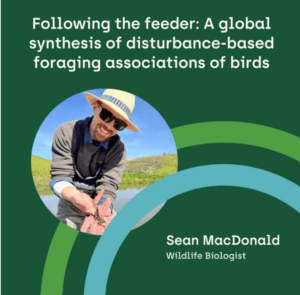Sean MacDonald Co-Authors New Article in the Journal of Animal Ecology
Congratulations to WRA Wildlife Biologist Sean Erroll MacDonald who co-authored a recently published article called “Following the feeder: A global synthesis of disturbance-based foraging associations of birds” in the Journal of Animal Ecology.
Click here to read the open-source article!

Abstract
Species interactions link animal behaviour to community structure and macroecological patterns of biodiversity. One common type of trophic species interaction is disturbance foraging—the act of obtaining food at a disturbance created by another organism. Disturbance foraging is widespread across the animal kingdom, especially among birds, yet previous research has been largely anecdotal and we still lack a synthetic understanding of how this behaviour varies geographically, phylogenetically and ecologically. To address these gaps, we conducted a comprehensive literature review to test focal hypotheses about disturbance foraging behaviour in birds. We found that avian disturbance foraging was geographically ubiquitous, occurring in both aquatic and terrestrial habitats across six continents and four oceans. Consistent with predictions based on established species diversity gradients in different habitat types, the majority of terrestrial observations occurred at tropical latitudes, whereas aquatic observations took place most frequently in temperate marine waters. Although disturbance foraging was widespread across the avian phylogeny, contrary to our prediction, the behaviour was also conserved phylogenetically (Pagel’s λ = 0.7) and clustered within suboscine landbirds in terrestrial environments and seabirds in aquatic environments. Similarly, although disturbers were taxonomically diverse as we predicted, interactions were unexpectedly dominated by swarm-raiding ants in terrestrial environments and cetaceans in aquatic environments. Diet and body mass were also important predictors of disturbance foraging associations: Responders followed disturbers with similar diets and larger body sizes. Overall, our hypothesis-testing framework provides insight into the importance of geography, phylogeny and ecology as predictors of disturbance foraging behaviour. We anticipate that this comprehensive assessment of disturbance foraging will serve to generate additional hypotheses and spark future research and management considerations about this fascinating but poorly studied suite of species interactions, especially as biotic interactions face unprecedented risks in our rapidly changing world.



